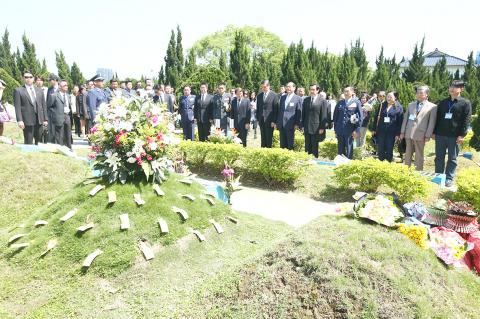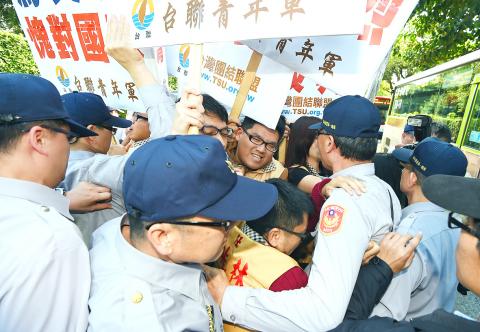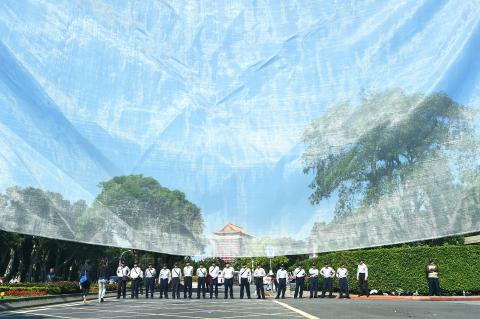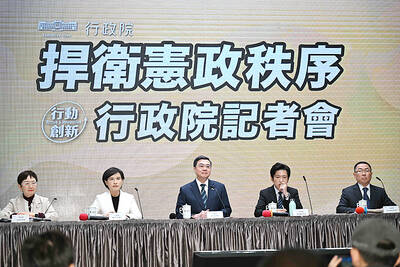The Taiwan Solidarity Union (TSU) and other groups yesterday protested at the Martyrs’ Shrine in Taipei, condemning what it called the government’s silence as China’s M503 flight route entered service.
President Ma Ying-jeou (馬英九) attended an annual spring memorial service under tightened security as protesters held signs urging the government to protest to China over the air route.
Protesters mobilized by the TSU showed up about 100m from the main entrance to the Martyrs’ Shrine almost immediately after the presidential convoy drove into the complex.

Photo: CNA
Other groups were present, such as Restoration of Taiwan Social Justice (臺左維新), but most were kept hundreds of meters away from the complex.
The TSU-led protesters tossed rotten eggs and slippers over police officers who blocked their entry.
“When we threw paint at the presidential residence, the Presidential Office immediately released a statement condemning our protest as an ‘act of violence,’ and urged us to remain peaceful and rational,” TSU youth director Chang Chao-lin (張兆林) said through a megaphone. “However, when China displays its intention to violate Taiwan’s sovereignty, Ma does not dare to say anything.”

Photo: Chien Jung-fong, Taipei Times
Chang criticized what he called the government’s acceptance when China announced that it would begin using the route, despite protests from Taiwan.
Hsu Ya-chi (許亞齊) echoed Chang and asked why the government once said that it was not happy with China’s unilateral designation of the route near the median line of Taiwan Strait, but eventually accepted it.
“If you are not happy, why would you accept it? The government is selling out Taiwan’s sovereignty,” he said.

Photo: Chien Jung-fong, Taipei Times
The protesters attempted to move forward, leading to brief scuffles with police officers.
Two protesters broke through the police line, but were stopped by a second phalanx of officers.
Separately, two men attempted to ride their motorcycles into the Martyrs’ Shrine while shouting “Cancel M503” and “Down with Ma Ying-jeou.”

Photo: Chien Jung-fong, Taipei Times
They were stopped by secret service agents and taken to a nearby military site for questioning.

The US government has signed defense cooperation agreements with Japan and the Philippines to boost the deterrence capabilities of countries in the first island chain, a report by the National Security Bureau (NSB) showed. The main countries on the first island chain include the two nations and Taiwan. The bureau is to present the report at a meeting of the legislature’s Foreign Affairs and National Defense Committee tomorrow. The US military has deployed Typhon missile systems to Japan’s Yamaguchi Prefecture and Zambales province in the Philippines during their joint military exercises. It has also installed NMESIS anti-ship systems in Japan’s Okinawa

‘WIN-WIN’: The Philippines, and central and eastern European countries are important potential drone cooperation partners, Minister of Foreign Affairs Lin Chia-lung said Minister of Foreign Affairs Lin Chia-lung (林佳龍) in an interview published yesterday confirmed that there are joint ventures between Taiwan and Poland in the drone industry. Lin made the remark in an exclusive interview with the Chinese-language Liberty Times (the Taipei Times’ sister paper). The government-backed Taiwan Excellence Drone International Business Opportunities Alliance and the Polish Chamber of Unmanned Systems on Wednesday last week signed a memorandum of understanding in Poland to develop a “non-China” supply chain for drones and work together on key technologies. Asked if Taiwan prioritized Poland among central and eastern European countries in drone collaboration, Lin

NO CONFIDENCE MOTION? The premier said that being toppled by the legislature for defending the Constitution would be a democratic badge of honor for him Premier Cho Jung-tai (卓榮泰) yesterday announced that the Cabinet would not countersign the amendments to the local revenue-sharing law passed by the Legislative Yuan last month. Cho said the decision not to countersign the amendments to the Act Governing the Allocation of Government Revenues and Expenditures (財政收支劃分法) was made in accordance with the Constitution. “The decision aims to safeguard our Constitution,” he said. The Constitution stipulates the president shall, in accordance with law, promulgate laws and issue mandates with the countersignature of the head of the Executive Yuan, or with the countersignatures of both the head of the Executive Yuan and ministers or

CABINET APPROVAL: People seeking assisted reproduction must be assessed to determine whether they would be adequate parents, the planned changes say Proposed amendments to the Assisted Reproduction Act (人工生殖法) advanced yesterday by the Executive Yuan would grant married lesbian couples and single women access to legal assisted reproductive services. The proposed revisions are “based on the fundamental principle of respecting women’s reproductive autonomy,” Cabinet spokesperson Michelle Lee (李慧芝) quoted Vice Premier Cheng Li-chiun (鄭麗君), who presided over a Cabinet meeting earlier yesterday, as saying at the briefing. The draft amendment would be submitted to the legislature for review. The Ministry of Health and Welfare, which proposed the amendments, said that experts on children’s rights, gender equality, law and medicine attended cross-disciplinary meetings, adding that